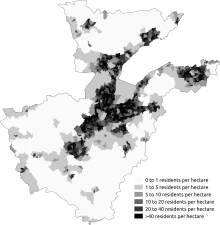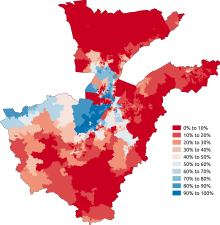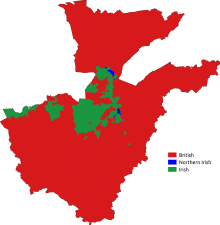Belfast Metropolitan Area
| Belfast Metropolitan Area | |
|---|---|
| Metropolitan Area | |
 Belfast Metropolitan Area Location in Northern Ireland | |
| Coordinates: 54°35′49″N 5°55′48″W / 54.597°N 5.930°WCoordinates: 54°35′49″N 5°55′48″W / 54.597°N 5.930°W | |
| Sovereign State | United Kingdom |
| Constituent Country | Northern Ireland |
| District | |
| County | County Antrim / County Down |
| Government | |
| • UK Parliament | |
| • EU Parliament | Northern Ireland |
| Area | |
| • Total | 370 sq mi (960 km2) |
| Time zone | GMT (UTC+0) |
| • Summer (DST) | BST (WEST) (UTC-1) |
| Area code(s) | 028 |
The Belfast Metropolitan Area is a grouping of council areas which include commuter towns and overspill from Belfast, Northern Ireland with a population of 579,276.[1]
Overview
The area was first officially classified as a Metropolitan Area in the late 1990s when the British government began to prepare for a cohesive plan that would include the Belfast Region. Six local government districts – Belfast, Castlereagh, Carrickfergus, Lisburn, Newtownabbey and North Down, were identified as the key areas within the Metropolitan Area. The continuous built-up area centred on Belfast, which is contained within these six districts, is defined as the Belfast Metropolitan Urban Area..[2]
The Area is made up of established towns, their overspill and the general con-joining of settlements as Belfast expands. Established towns include Carrickfergus, Bangor, Lisburn and Holywood. Many of these towns were established and important long before Belfast rose to prominence; Carrickfergus, for example, was the Norman capital of the northern part of Ireland. Bangor had been an important centre of Christianity and learning from its foundation in 555 AD. The recent re-classification of Lisburn as a city does not change its position within the Metropolitan Area.
Places in the conurbation
| Rank | Urban Area[1] | Population
(2001 Census)[1] |
|---|---|---|
| 1 | Belfast Urban Area | 276,605 |
| 2 | Lisburn Urban Area | 71,403 |
| 3 | Newtonabbey Urban Area | 62,022 |
| 4 | Bangor | 58,368 |
| 5 | Castlereagh Urban Area | 54,636 |
| 6 | Carrickfergus | 27,192 |
| 7 | Holywood Urban Area | 12,027 |
| 8 | Carryduff | 6,564 |
| 9 | Greenisland | 5,067 |
| 10 | Groomsport & Crawfordsburn | 1,401 |
| 11 | Helen's Bay | 1,356 |
| 12 | Milltown | 1,356 |
| 13 | Seahill | 1,179 |
| Total | Belfast Metropolitan Urban Area | 579,276 |
2001 census
At the 2001 census, the demographic characteristics of the people living in Belfast Metropolitan Urban Area (BMUA) were as follows:[3]
- 22.0% were aged under 16 years and 19.2% were aged 60 and over
- 47.4% of the population were male and 52.6% were female
- 40.5% were from a Catholic background, 55.5% were from a Protestant background.
- 4.3% of people aged 16–74 were unemployed
Population maps
In the 2011 UK Census, the distributions of population, religion, national identity and proportion of immigrants within the Belfast Metropolitan Area, were as follows.
|
References
See also
- Districts of Belfast
- Greater Dublin
- Derry Urban Area
- Greater Cork
- List of conurbations in the United Kingdom
- Dublin-Belfast corridor (population under three million)



